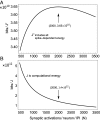Communication consumes 35 times more energy than computation in the human cortex, but both costs are needed to predict synapse number
- PMID: 33906943
- PMCID: PMC8106317
- DOI: 10.1073/pnas.2008173118
Communication consumes 35 times more energy than computation in the human cortex, but both costs are needed to predict synapse number
Abstract
Darwinian evolution tends to produce energy-efficient outcomes. On the other hand, energy limits computation, be it neural and probabilistic or digital and logical. Taking a particular energy-efficient viewpoint, we define neural computation and make use of an energy-constrained computational function. This function can be optimized over a variable that is proportional to the number of synapses per neuron. This function also implies a specific distinction between adenosine triphosphate (ATP)-consuming processes, especially computation per se vs. the communication processes of action potentials and transmitter release. Thus, to apply this mathematical function requires an energy audit with a particular partitioning of energy consumption that differs from earlier work. The audit points out that, rather than the oft-quoted 20 W of glucose available to the human brain, the fraction partitioned to cortical computation is only 0.1 W of ATP [L. Sokoloff, Handb. Physiol. Sect. I Neurophysiol. 3, 1843-1864 (1960)] and [J. Sawada, D. S. Modha, "Synapse: Scalable energy-efficient neurosynaptic computing" in Application of Concurrency to System Design (ACSD) (2013), pp. 14-15]. On the other hand, long-distance communication costs are 35-fold greater, 3.5 W. Other findings include 1) a [Formula: see text]-fold discrepancy between biological and lowest possible values of a neuron's computational efficiency and 2) two predictions of N, the number of synaptic transmissions needed to fire a neuron (2,500 vs. 2,000).
Keywords: bits per joule; brain energy consumption; energy-efficient; neural computation; optimal computation.
Conflict of interest statement
The authors declare no competing interest.
Figures




Comment in
-
Brain power.Proc Natl Acad Sci U S A. 2021 Aug 10;118(32):e2107022118. doi: 10.1073/pnas.2107022118. Proc Natl Acad Sci U S A. 2021. PMID: 34341108 Free PMC article. No abstract available.
References
-
- Levy W. B., Baxter R. A., Energy efficient neural codes. Neural Comput. 8, 289–295 (1996). - PubMed
-
- Alexander R. M., Optima for Animals (Princeton University Press, 1996).
-
- Balasubramanian V., Kimber D., Berry M. J. II, Metabolically efficient information processing. Neural Comput. 13, 799–815 (2001). - PubMed
-
- Sterling P., Laughlin S., Principles of Neural Design (MIT Press, 2015).
MeSH terms
LinkOut - more resources
Full Text Sources
Other Literature Sources
Miscellaneous

